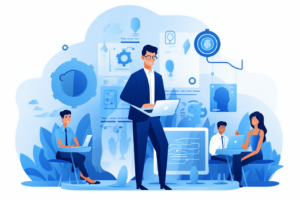Gen AI myths debunked: transforming your workforce with upskilling & reskilling
- 6 Min Read
Debunking Gen AI myths: effective upskilling and reskilling are key to unlocking workforce potential in the age of automation
- Author: Anna Lisova
- Date published: Oct 17, 2023
- Categories

In today’s rapidly evolving technological landscape, artificial intelligence (AI) is revolutionizing various industries, including learning and development (L&D) and human resources (HR). With the emergence of generative AI (Gen AI), there are several misconceptions that need to be addressed.
This article will aim to debunk these myths and shed light on the potential benefits and implications of generative AI in the L&D and HR sectors.
Myth #1: Gen AI will replace L&D teams
One prevalent myth about Gen AI is that it’s destined to replace entire teams, including L&D departments. While it’s a concern rooted in the rapid evolution of technology, the reality is far more nuanced.
Firstly, let’s debunk the Hollywood portrayal of AI. The image of sentient robots like the Terminator or WALL-E is far from the AI we’re currently integrating into our workplaces. Gen AI, or Narrow AI, is more akin to your phone’s autocorrect feature than a movie star robot.
Unlike their cinematic counterparts, which exhibit Artificial General Intelligence (AGI) complete with common sense, creativity, and emotions, Gen AI focuses solely on specific, limited tasks. These tasks require human input, and the AI itself lacks self-awareness, consciousness, or independent thought. While AGI may appear in science fiction, it’s not yet a reality and may never be.
With Gen AI, human skills such as critical thinking, emotional intelligence, and objective reasoning remain essential. Instead of automating jobs, we’re moving towards augmenting our work with AI, creating a symbiotic relationship between humans and technology.
At Hive Learning, we embrace this concept through our ‘AHAH’ principle. “AHAH” stands for AI-assisted, Human-led, AI-resourced, Human-checked. This principle emphasizes the balance between AI and human involvement, ensuring that while AI assists and resources the work, humans still lead and check the processes. It’s a blended approach that maximizes the benefits of AI while maintaining the unique value of human input.
Myth 2: Gen AI can’t personalize learning
Since the emergence of widely available Gen AI tooling in the workplace, Gen AI has demonstrated its effectiveness in creating large volumes of learning content quickly, enabling L&D and HR teams to achieve more in less time. But the Gen AI revolution doesn’t stop there.
We’re now witnessing a transition from Gen AI to Synthetic AI (Synth AI), where AI’s capabilities are expanding to include the synthesis and analysis of information. This advancement allows for the proactive curation of hyper-contextualized learning content, tailored to the learners’ needs and based on existing or new assets.
This shift means L&D teams can breathe new life into dormant legacy content, revitalizing it in a context relevant to current needs. Synth AI truly augments the expertise of L&D teams, enabling them to deliver more relevant, contextual learning on a larger scale than ever before.
Discover how Hive Learning is harnessing the power of Synth AI to empower organizations in their learning journey.
Myth 3: Gen AI can’t teach complex skills
While AI-powered technologies like Generative AI (Gen AI) and Synthetic AI (Synth AI) lack emotional intelligence, they can still play a pivotal role in fostering human soft skill development alongside technical skills.
AI technology leverages Natural Language Processing (NLP), a sophisticated tool that analyzes text, speech, and communication patterns. Through NLP, AI can evaluate and guide the development of critical soft skills, providing insightful feedback and learning opportunities.
Moreover, AI has proven remarkably effective in creating virtual scenarios for safe, controlled skill practice. These immersive environments are particularly beneficial for honing skills such as conflict resolution, leadership, and analysis.
In this way, AI not only supports the development of technical proficiencies but also enhances interpersonal skills and emotional intelligence – key competencies for the future of work.
Myth 4: Gen AI can’t address specific industry needs
Contrary to the misconception that AI offers a ‘one-size-fits-all’ solution, Gen AI is actually adept at delivering contextually relevant learning experiences.
Gen AI can analyze multiple data points, including employee performance metrics, learning preferences, and business objectives. This analysis allows Gen AI to craft personalized learning experiences that align with both individual and organizational needs.
By harnessing the power of Gen AI, L&D and HR leaders can ensure their learning initiatives are intricately linked to strategic objectives, thereby maximizing their impact on business outcomes. This approach reflects the true potential of AI in revolutionizing workforce upskilling and reskilling.
Navigating AI interactions: best practices & tips
Navigating interactions with AI requires understanding, as well as continuously adapting and exploring new ways to enhance its uses. Here are some key things to remember when using AI:
- AI mimics human behavior: Despite seeming human-like, AI is capable of a lot, but it doesn’t know you or your context and can sometimes repeat content.
- AI can be unpredictable: The same prompt can elicit different responses each time, so don’t be surprised by varied outputs.
- Fact checking: Ask AI for Taylor Swift’s latest album, and it may say “Folklore”. You must fact check your AI generated content.
- Bias in AI: AI, like Gen AI, uses content prompts and language models to function. However, without a conscience, morals, or historical context, it could unintentionally produce biased content.
- Original research: AI can’t perform original research or analysis. While it can generate content, it’s usually basic – you’ll need to add research to enhance your pieces.
AI is a tool to accelerate human creativity and people are the creators. To communicate effectively with AI, remember:
- You’re accountable: Always critically evaluate the advice given by AI.
- You’re in control: You can always redirect the conversation if the AI gets stuck in a loop.
- Seek clarity: If you don’t understand the AI’s explanation, ask it to rephrase or provide more examples.
- Provide context: The more detail you provide, the better the AI can help.
- Don’t rely on AI’s memory: If it seems confused, remind it of what you need.
- Privacy matters: Avoid sharing personal information. Anything shared may be used as training data for the AI.
Moreover, it’s crucial to provide sufficient training and resources to employees to familiarize them with AI technologies. Addressing fears, debunking common myths and providing ongoing support can foster a sense of reassurance and encourage acceptance and adoption of generative AI in the workplace.
Conclusion
In an era where objectives shift quickly and staying future-proof is vital, Gen AI emerges as an opportunity, not a threat. By dispelling myths and embracing AI, organizations can empower their workforce, stay ahead of the skills gap, and navigate the ever-changing business landscape successfully.
If you want to find out more about how you can leverage AI to empower your L&D team to deliver hyper-contextualized learning, reach out to a member of the Hive Learning team today.








